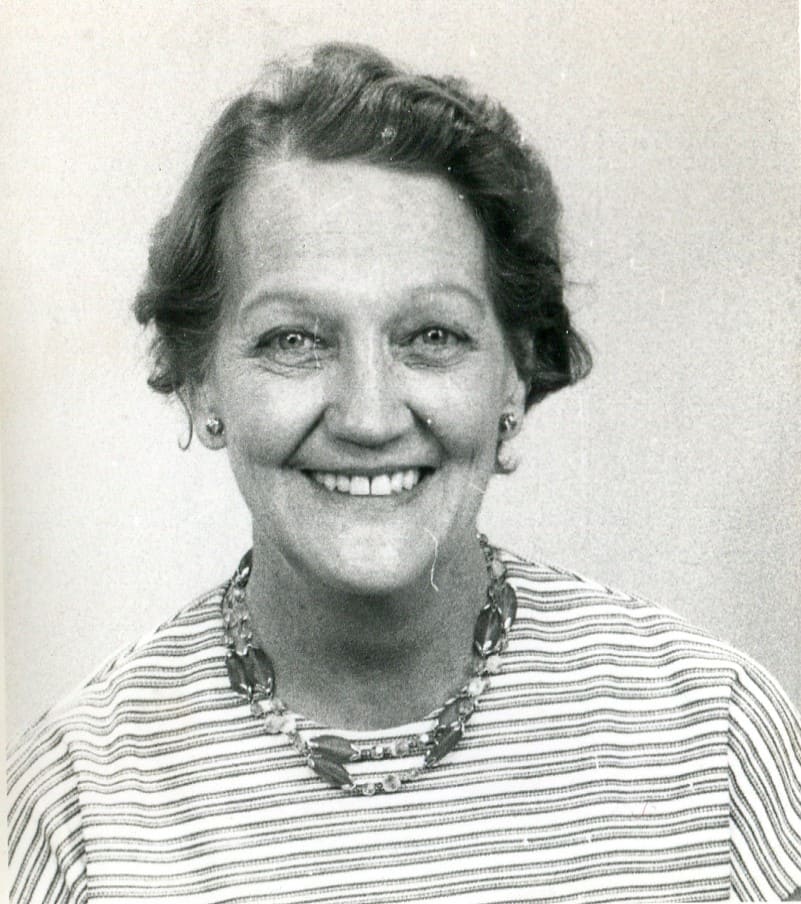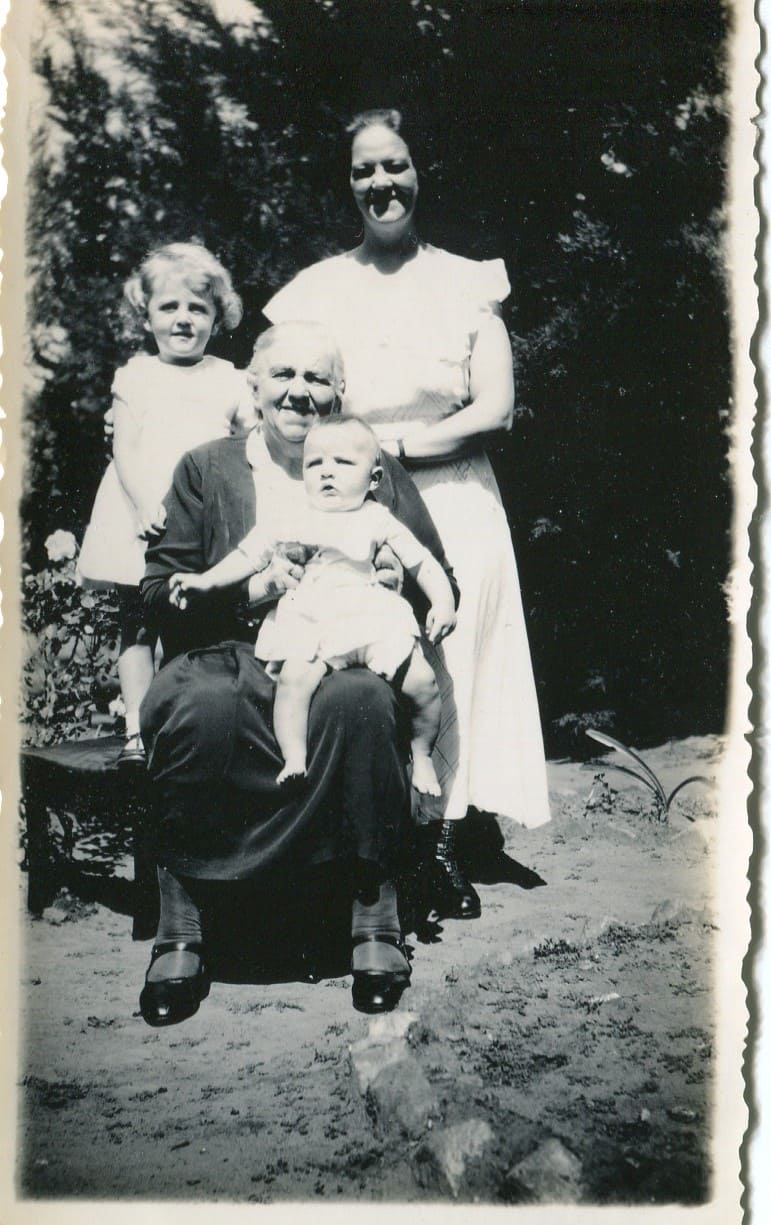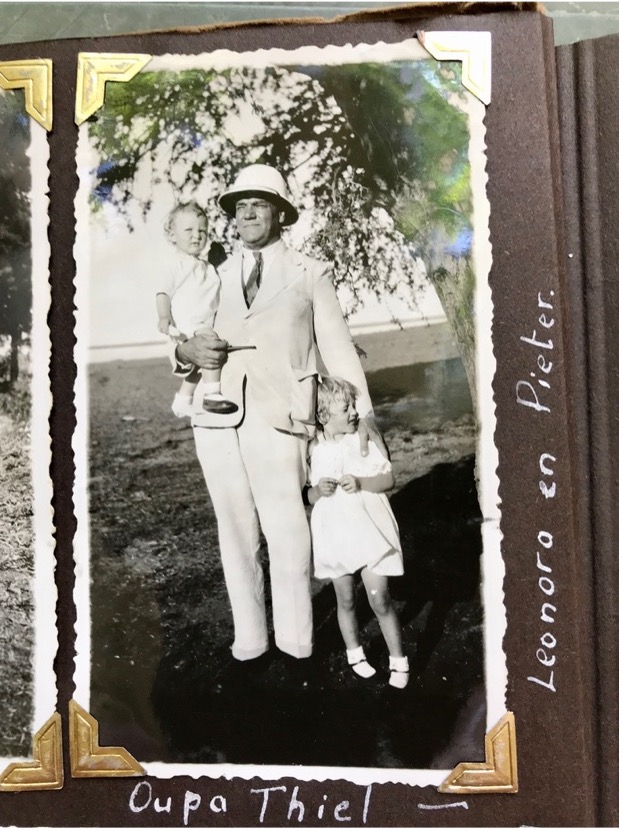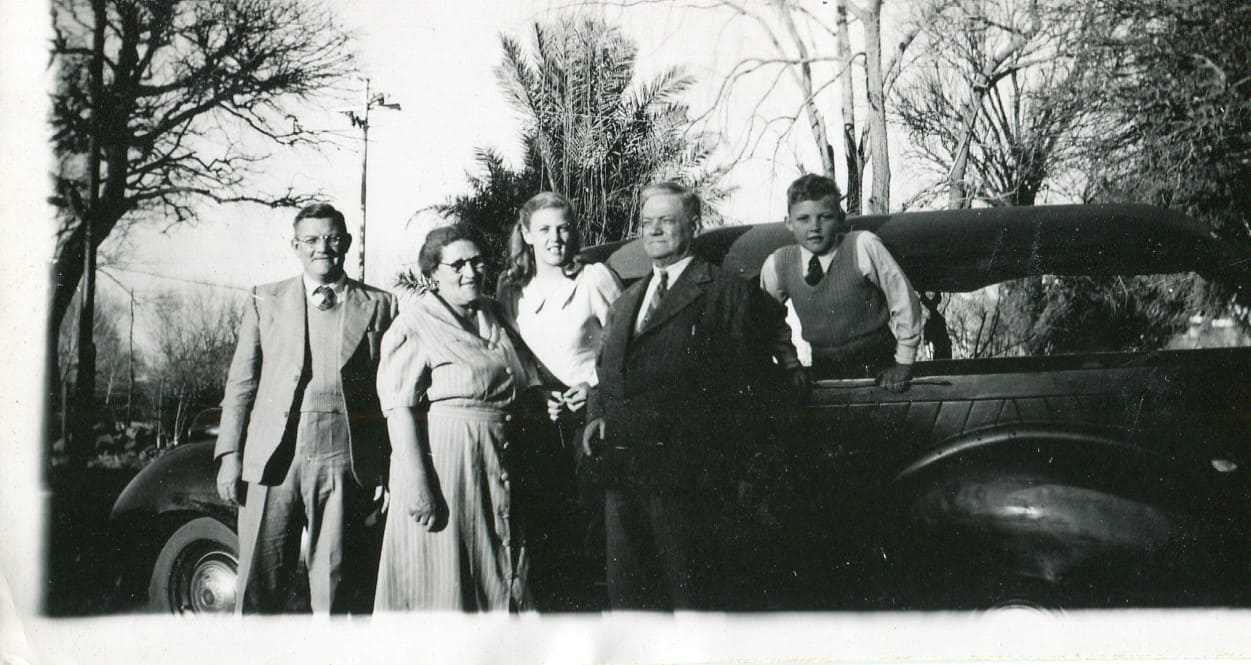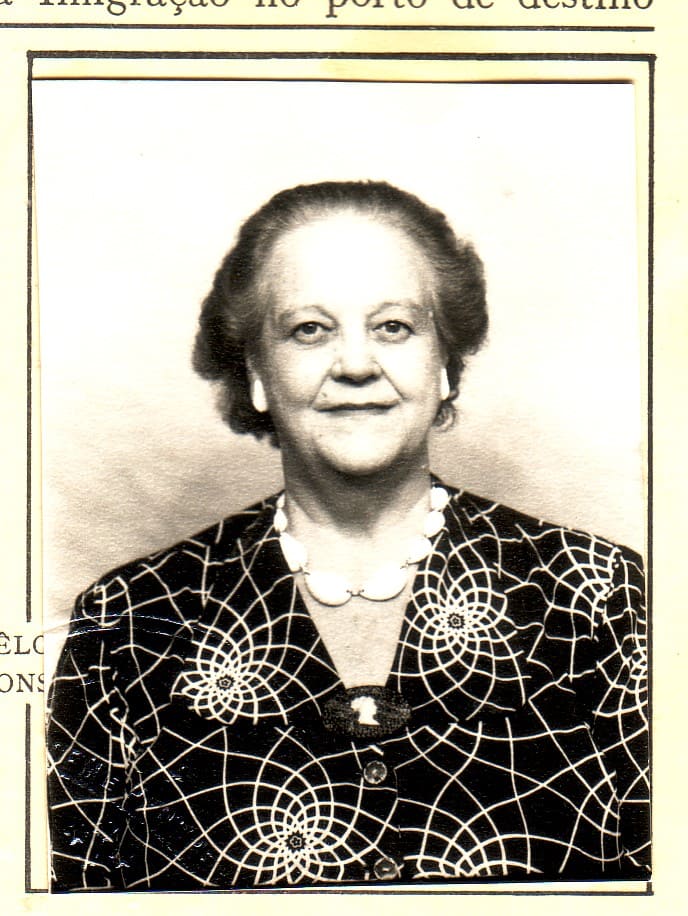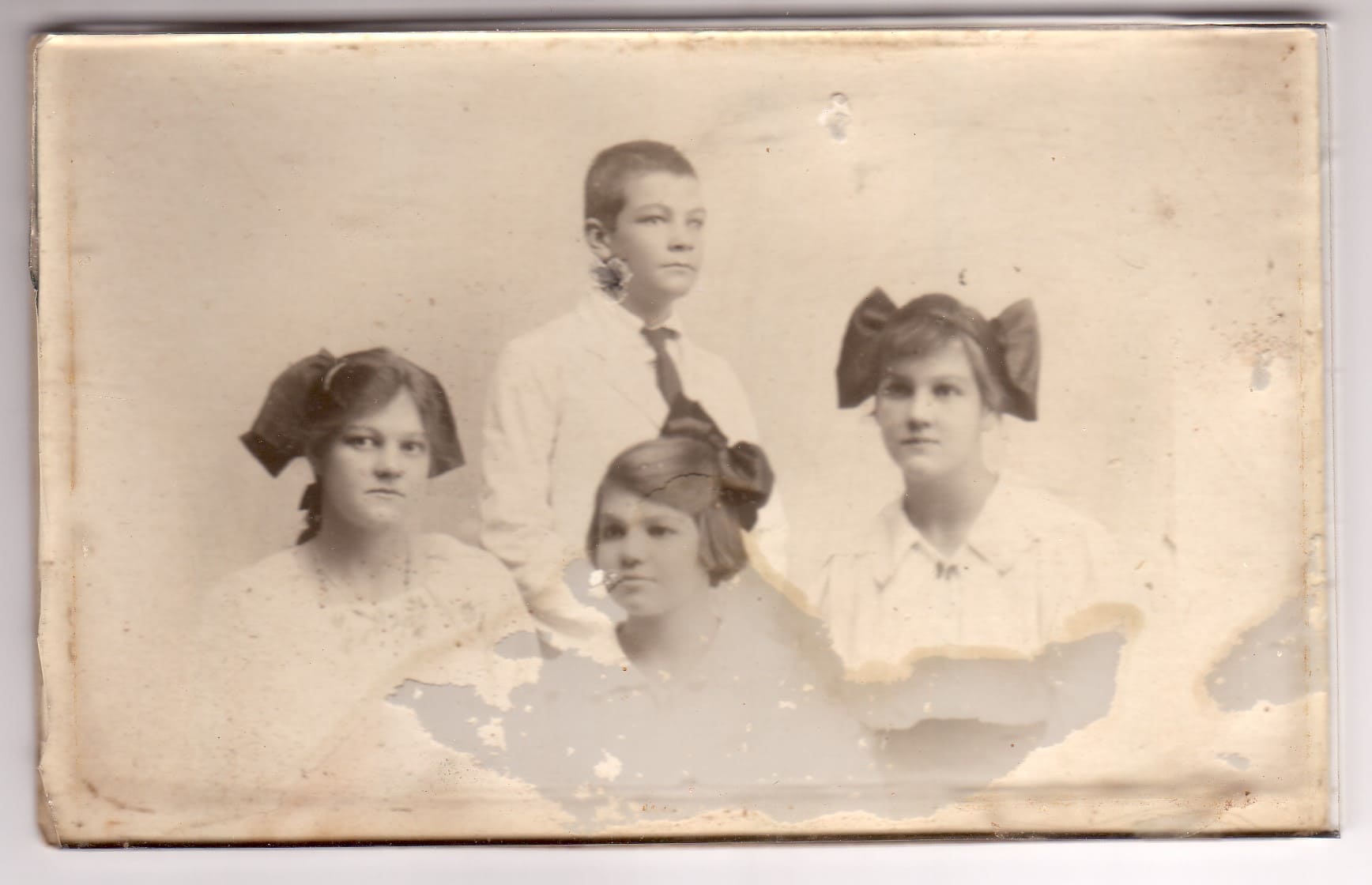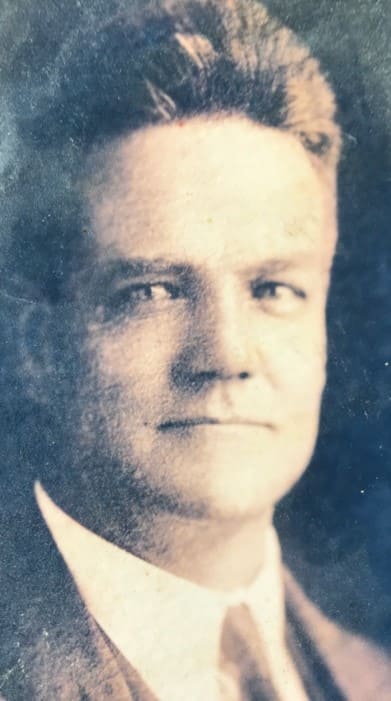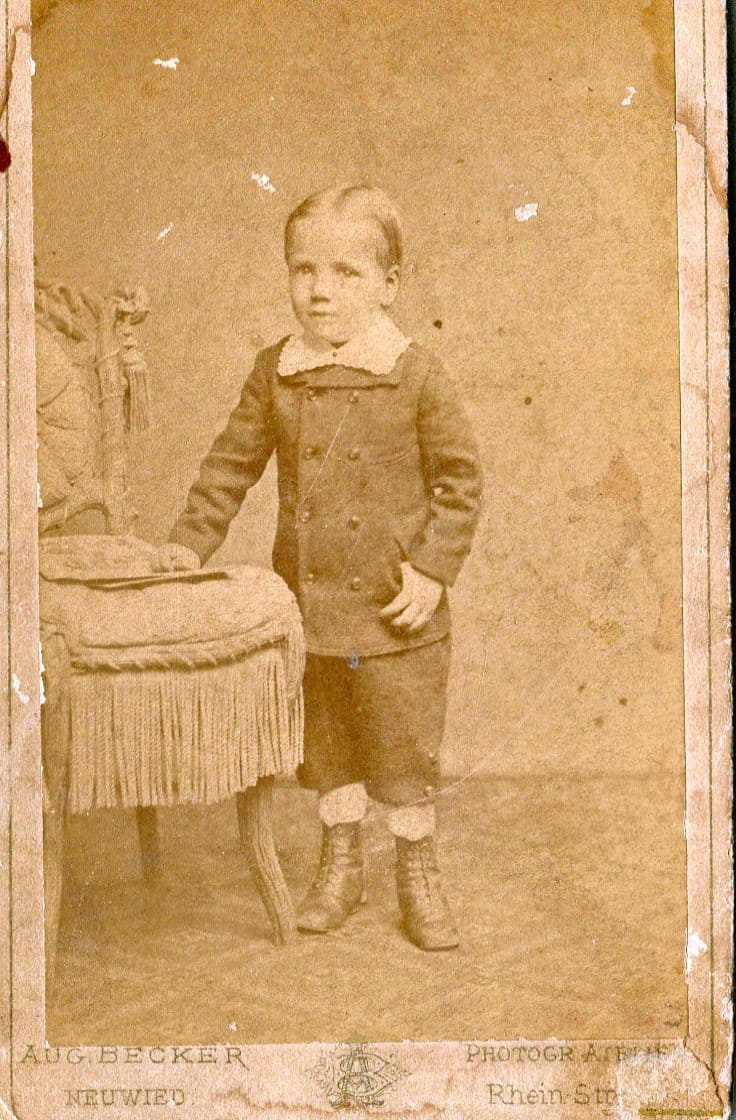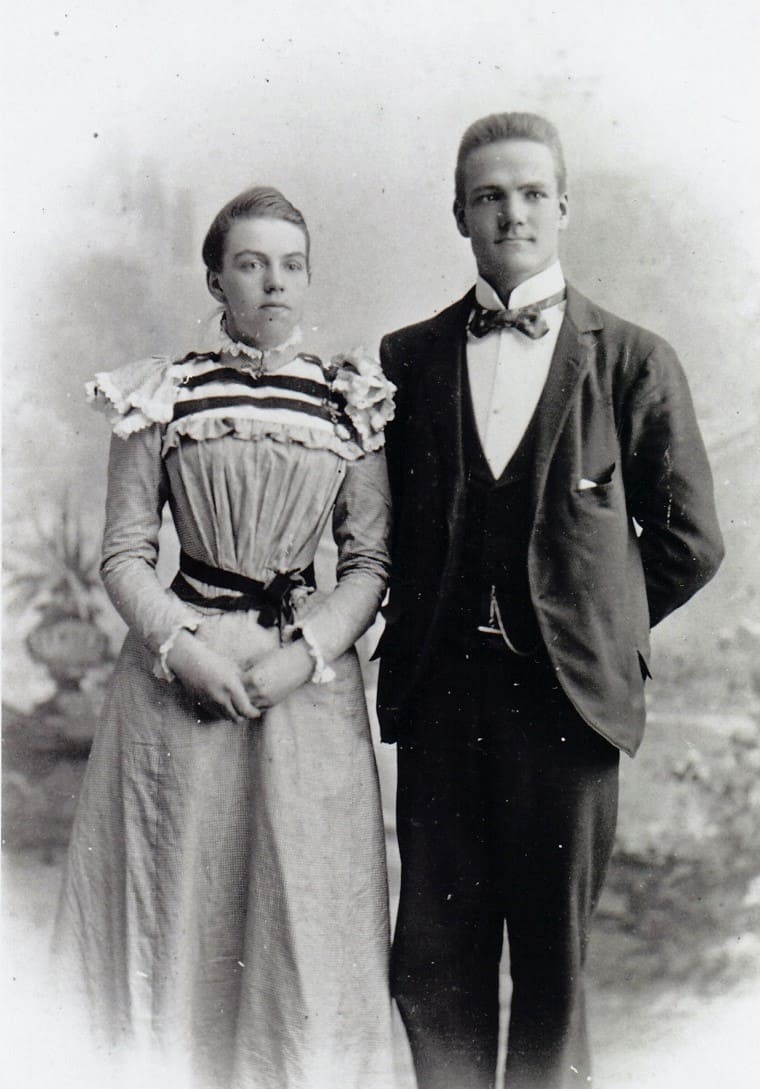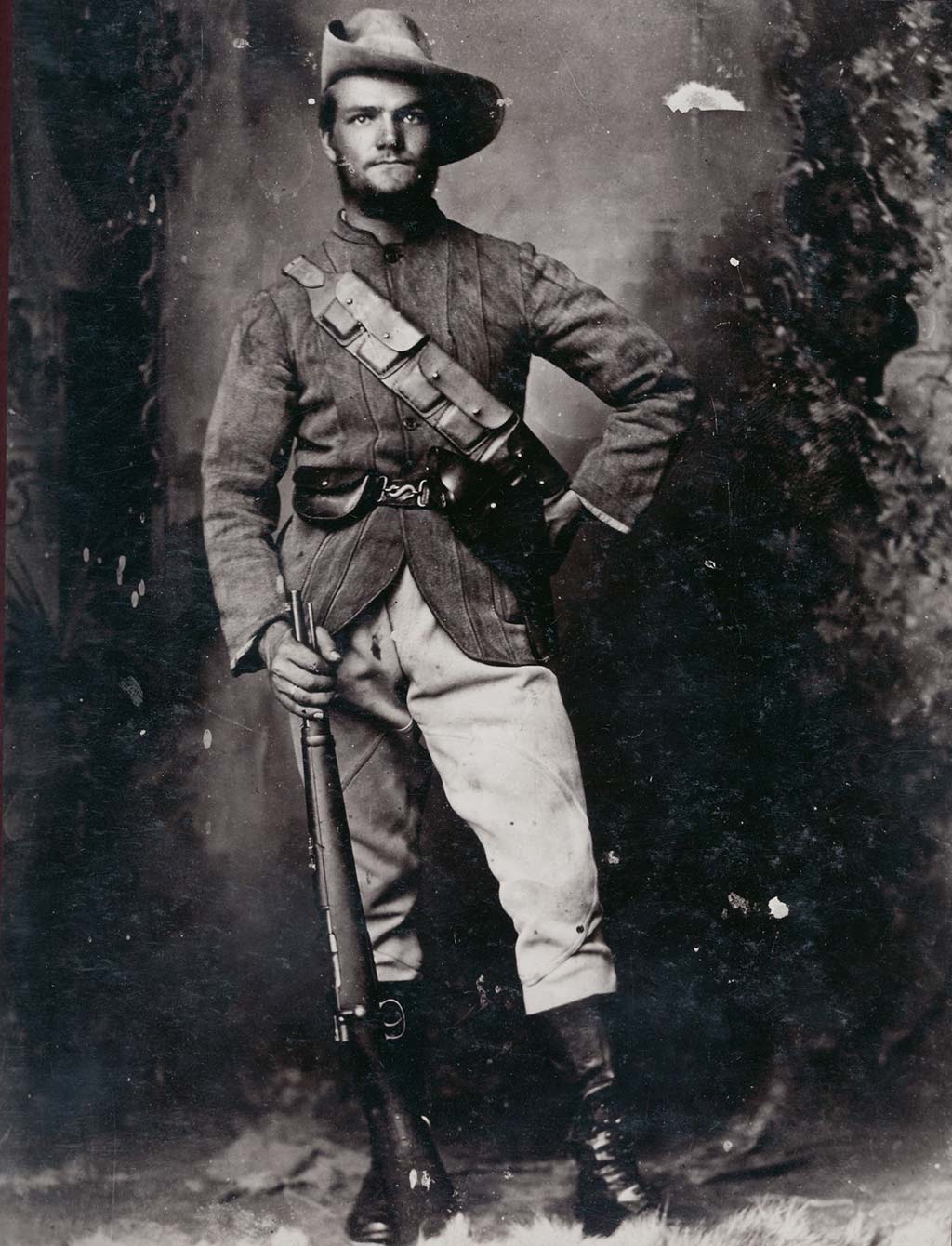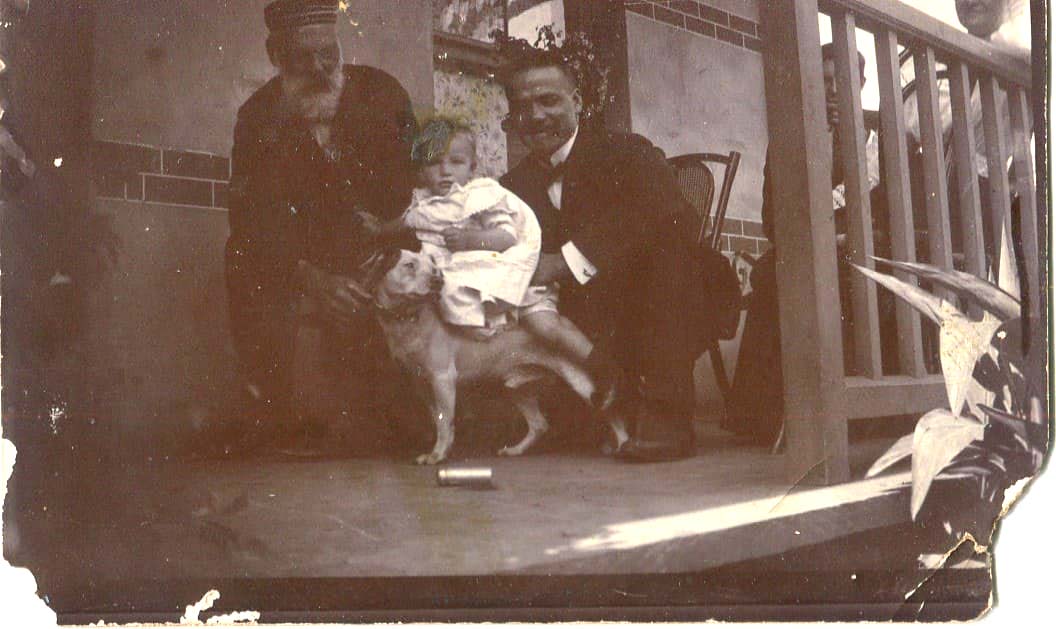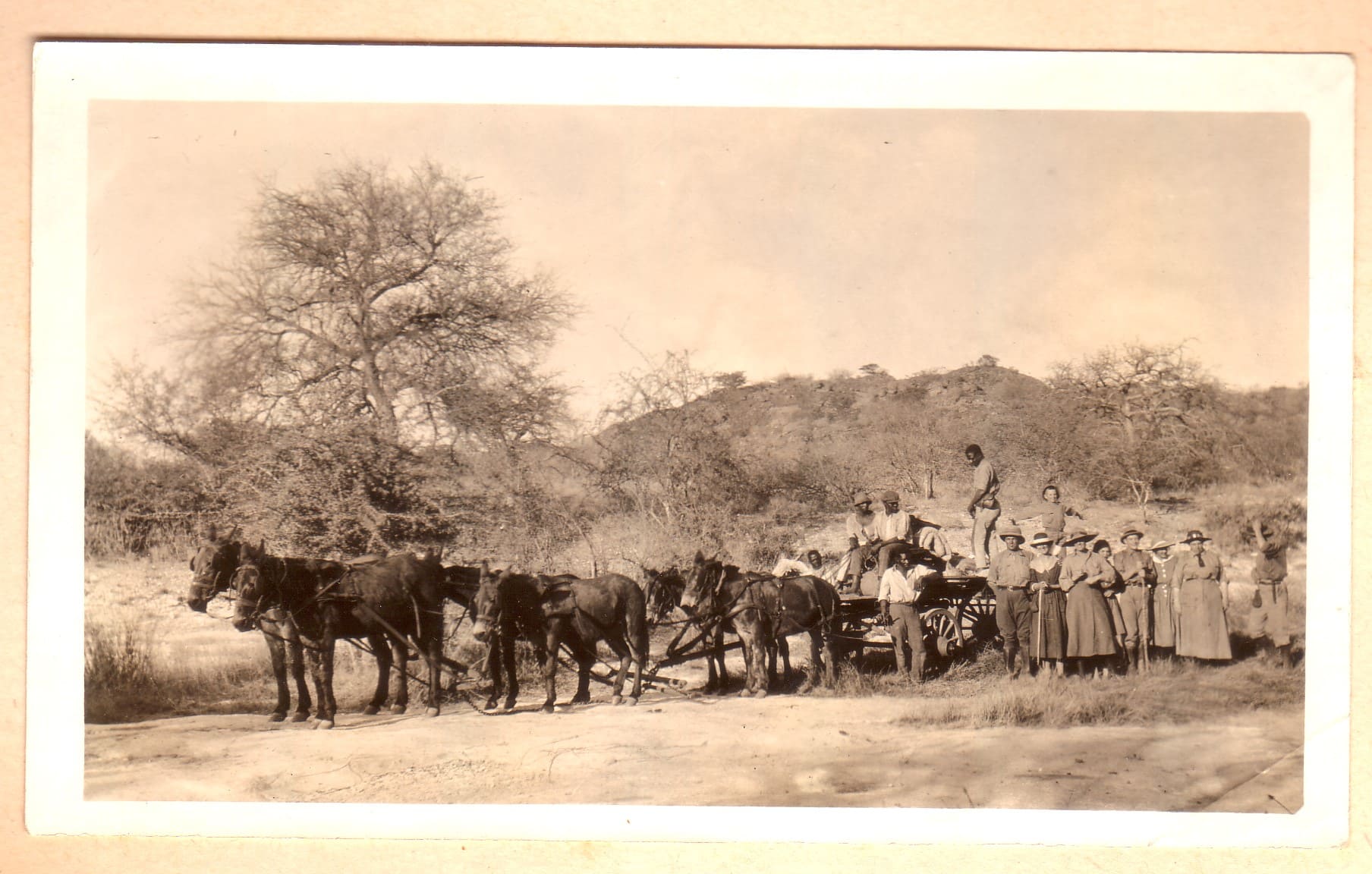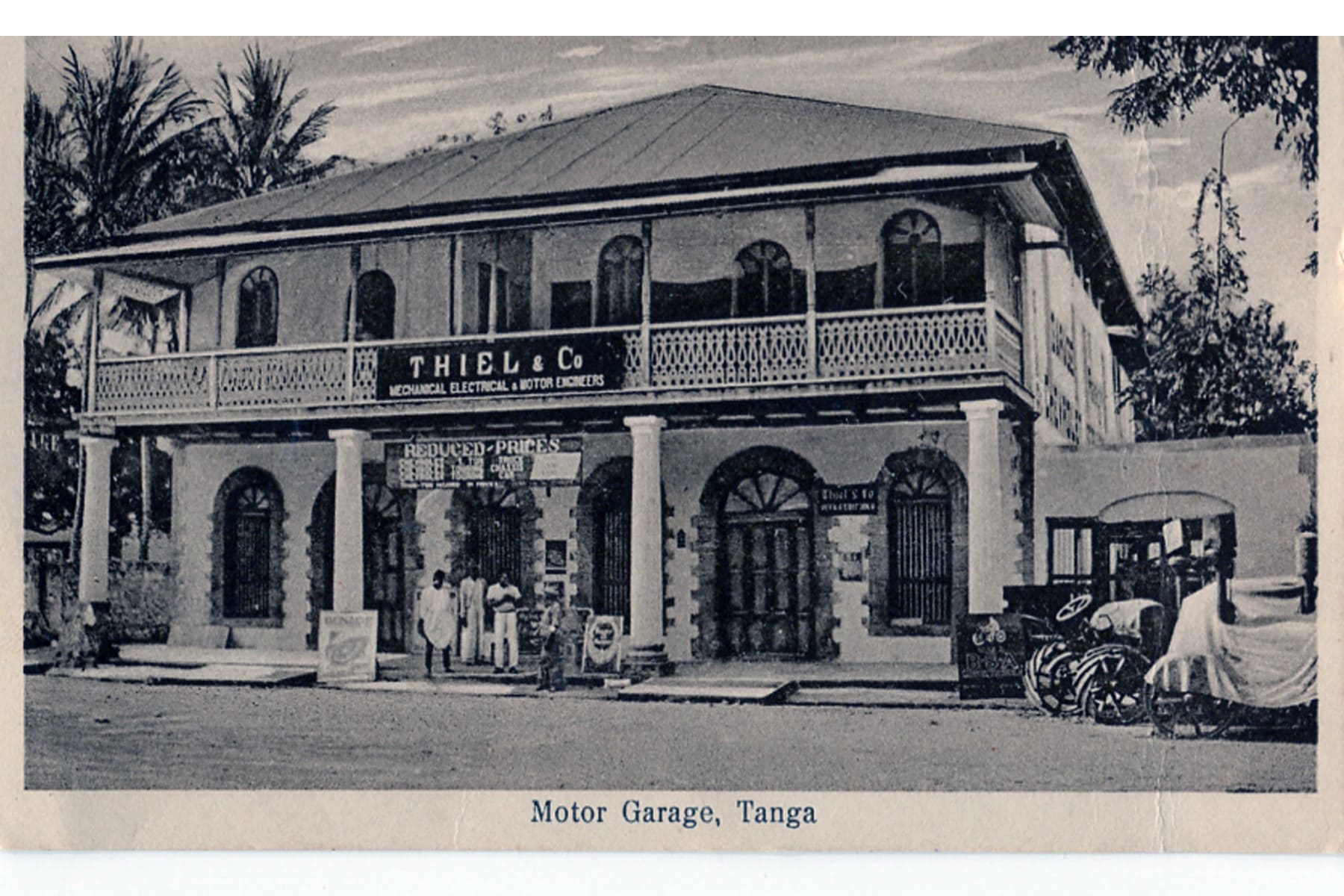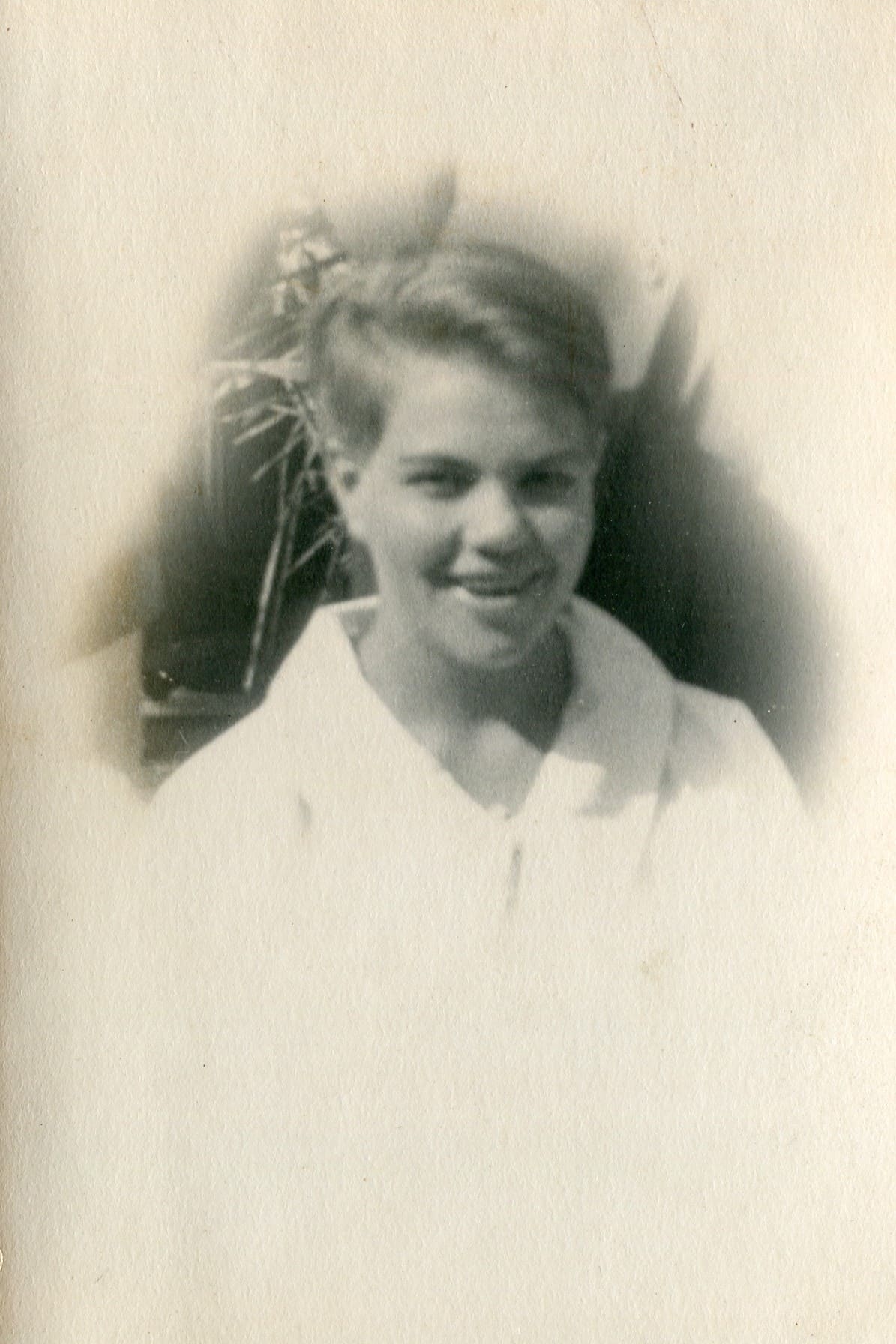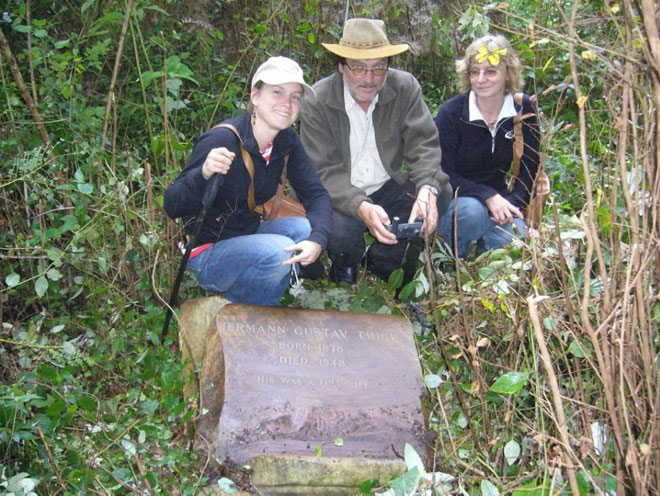Hermann Gustav Thiel
AND HIS DESCENDANTS
Special Acknowledgements
The information about our Grandfather, Hermann Gustav Thiel, was obtained directly from his children. Our own father, Hermann Paul Emil Thiel, and his one sister, Petronella Ernstina Thiel, did not accompany their parents when they moved to Tanganyika in 1922. Their recollections were mostly about their holidays in Messina as the children went to school in Pretoria and only joined their parents during school holidays.
Our grandfather and grandmother never visited South Africa together again. Our grandmother visited on her own a few times, once for our parents’ wedding in 1929 and once for a long visit in 1936 when we were living in Wolmaransstad.
Petronella Ernstina Kleinenberg
Our grandmother Cornelia Thiel with my sister Leonora
and myself and our Aunt Corrie.
Our grandfather visited only twice, in 1937 and again ten years later. We were still young and gained very little from his brief visits.
Our information on our grandfather came mostly from the two children who accompanied our grandparents to East Africa. When the eldest daughter, Corrie (Cornelia Pauline Philomina Thiel) returned to South Africa in 1954 she brought a wealth of information with her in the form of copies of correspondence, photos and other memorabilia collected by our grandfather over his lifetime including valuable souvenirs from his participation in the Anglo-Boer War. She passed these items on to her brother Hermann who was then practicing as a lawyer in Potchefstroom. After he passed away in 1992 the material was added to my private collection in Stellenbosch. Some of the material from the Anglo Boer War has been exhibited at philatelic meetings in South Africa and Britain and published in the newsletter of the Anglo Boer War Philatelic Society.
Most of our information about the life of our grandparents in Tanganyika came from their youngest child, our Uncle Peter (Ernst Pieter Thiel) who joined his parents in East Africa and spent a large part of his life in Tanganyika, Kenya and Uganda. He visited us often in South Africa, initially from East Africa but later also from Australia where he passed away in Perth in 2005. He had a keen interest in the family history and an excellent memory for dates, events and people. During his visits to us in Stellenbosch in 1985 and 1989 I recorded some of our conversations. These recordings were of tremendous assistance in the compilation of this document about our grandparents.
Hermann Gustav Thiel
Childhood Years
Hermann was the youngest child of Gustav Thiel (1825-1907) and his second wife, Anna Maria Catharina Gertrud Rausch (1838-1906). He was born on 23 March 1878 on the family farm, Höltgestal after the family had returned to Germany from Palestine where they had spent the previous 20 years. He was only 2 months old when his father departed to settle in Kimberley.
He was 4 years old when he with his mother and the rest of the family joined his father in 1882. He received his first schooling in English as well as in German from a German missionary in Kimberley. The family moved to Cape Town in 1889 where he completed his schooling in English. On 30 July 1892, at the age of 14, he received a school certificate from the University of the Cape of Good Hope. The Thiel family moved to Johannesburg in 1892 where he completed his apprenticeship as a technician by working for the Clyde Iron Works in Frederick Street from 1893 to 1896.
Period before the
Anglo-Boer War
From 1896 Hermann Thiel worked for The South African Contracting Association which belonged to H.C. Werner. In their service he was involved in the construction of Fort Klapperkop outside Pretoria. On 21 January 1898 he was awarded citizenship of the Zuid Afrikaansche Republiek according to the Executive Council Decision 66 of 20 January 1898 based on his “Active service (Kommandodienst) in connection with the riots (onluste) at the end of 1895 and the beginning of the 1896.” He therefore did active military service for the Zuid Afrikaansche Republiek during the Jameson Raid and motivated this decision years later in a letter to the Regent Institute in London by saying that he regarded the Jameson Raid as a “filibustering expedition”. He joined the State Artillery of the ZAR in 1898 as First Machinist and in this capacity took part in the Anglo-Boer War (1899-1902) to protect the two Boer Republics against the imperialist attacks by the British.
On 3 January 1899 Hermann Thiel married Cornelia van Ameijde (1870-1942) in the Deutsche Evangelische Kirche in Pretoria. Cornelia was born on 17 June 1870 in Oudewater, The Netherlands. She qualified as a nurse in Amsterdam in October 1895 and moved to Pretoria where she started working as a nurse at the Volkshospitaal in Pretoria on 2May 1896. She was promoted to matron on 13 May 1898 but left the service in January 1899 when she married Hermann Thiel. Their first child, Martha Philomina Johanna was born during that year.
Participation in the
Anglo-Boer War
During the first phase of the war Hermann Thiel was in command of the search light section of the State Artillery near Ladysmith and Colenso in Natal and he was later transferred to the eastern and northern Transvaal where he undertook repairs of guns such as the Long Toms, Krupps and Pom-poms for the State Artillery.
In his diaries written during the war as well as in a letter he wrote in 1938 to the Regent Institute in London he described how he personally blew up the last of the four Long Tom guns in the northern Transvaal to prevent it from falling into the hands of the enemy. He added that he “was highly amused at the assertion in some English and South African papers last year (1937) about Long Toms that had been captured”.
In 1899 Hermann Thiel’s wife, Cornelia was sent to a farm in the Lydenburg district to tend to the health of a Boer family. While she was there the British troops approached the farm causing the family to flee while she decided to stay behind. She was taken with her firstborn child, Martha, to Lydenburg to assist with the nursing of wounded British soldiers. She won the trust of the British commander to such an extent that he made it possible for her to meet her husband, Hermann, under a white flag in the countryside outside Lydenburg. Their little daughter passed away on 7 August 1900 in Lydenburg. She then returned to Pretoria via Nylstroom where her husband’s brother, Karl, owned a hotel.
On 2 June 1901 Hermann Thiel was taken prisoner by the British forces under colonel J. Colenbrander on the farm of Nyskes, north east of Pietersburg. He was then most probably a member of the Soutpansberg Commando of Commandant M.J.P. Bierman. He was suffering from Blackwater fever at the time and had the unusual experience that his two guards turned out to be two of his school friends from Cape Town. Hermann was taken to Pretoria and admitted to the O.C. Racecourse hospital to be treated for fever where his wife visited him in June 1901. He was then transferred to Ladysmith, Natal where he joined the other prisoners of war in the Tin Town Camp. From there they were taken to Durban and on 12 August 1901 he departed with 932 fellow prisoners of war on board the S.S. Montrose for the Bermuda Islands. They arrived in the Bermuda Islands on 13 September 1901. In his diaries he recorded their journey by noting their exact position almost every day. He also noted the ship’s position where 23 Prisoners of War died and were buried at sea as well as their full names, ages and places of origin in the Zuid Afrikaansche Republiek.
Prisoner of war on the Bermuda Islands
During the period he spent on Bermuda he was moved to different islands on the archipelago and kept detailed diaries describing life in the Prisoner-of-War camps. Apart from the diaries he compiled a remarkable album containing documents, his correspondence with the British commander on Bermuda on behalf of the burgers under his command, other correspondence and the envelopes for the letters he received from the Transvaal, the Netherlands and Germany as well as sketches and photos depicting life on the Bermuda Islands. He dedicated this album to his wife, Cornelia, and took it with the family to Tanganyika when they moved there in 1922. After he passed away his daughter Cornelia brought it back to South Africa. She then passed it on to his son Hermann in Potchefstroom. The album also contained a detailed description of 24 Hours in a Prisoner of war camp. On 29 April 1903 he sent a copy of this description under the title of A day in the life of a Boer Prisoner of War on the Bermuda Islands to Gustav Preller, the editor of the newspaper Land en Volk who had invited readers to submit newsworthy reports about the war as material for a book which was unfortunately never completed. Some of these items will be presented separately. During his time in Bermuda his second child Cornelia Pauline Philomina was born in Pretoria.
He was one of the last to sign the Oath of Allegiance to the British Crown on 16 July 1902 on Darryll’s Island on Bermuda. Hermann Gustav Thiel returned to Cape Town on the R.M.S. Aurania of the Cunard Line and arrived in the Pretoria during October 1902.
The period after the Anglo Boer War
On his return to the Transvaal Hermann stayed in Pretoria with his wife and his young daughter Cornelia Pauline Philomina (1901-1982) who was born while he was a Prisoner of War in Bermuda. From November 1902 until December 1907 he was employed by the Electrical and General Engineers, Delfos Bros. & Company. Three children were born in Pretoria – Petronella Ernstina (1904 – 1995), Hermann Paul Emil (1905 – 1992) and Leonora Johanna (1907 – 1928).
In December 1907 the family moved to Maraisburg, Johannesburg where Hermann worked for The Consolidated Main Reef Mines & Estate. Two children were born in Maraisburg – Gustav Otto Theodor (1908 – 1909) and Ernst Pieter (1910 – 2005).
In December 1910 Hermann resigned and took up the position of Resident Engineer at the Messina Copper mine for The Messina (Transvaal) Development Company, Ltd.
Three Thiel generations in 1906. Gustav, Herman Gustav and Hermann Paul Emil.
Life in Messina from 1910 until November 1922
The Thiel family lived in Messina through the momentous time of the First World War and Flu epidemic of 1918/1919. The younger children first went to school in Messina and then they all went to Pretoria. The three girls attended the Diocesan School for Girls and the two boys went to the Pretoria Boys High School. They went home for their holidays and the family often went on camping trips along the Limpopo river.
Both Hermann Thiel and his wife were active in the community of this young copper town. He served on the Zoutpansberg School Board, the School Committee, as an official of the Rifle Club and as a Member of the Road Board. During the Great Flu Epidemic of 1918 his wife assisted at the local hospital when all the members of the nursing staff succumbed to the flu. Due to her training as a nurse in The Hague in the Netherlands and her experience as the Matron of the Zuid Afikaansche Hospitaal in Pretoria she was well qualified for the task. Her outstanding contribution was acknowledged in a letter from the management of the Messina Mining Company.
Hermann, with Corrie, Nell and Norah in 1919
In 1920 the copper price dropped and the company decided to cease production but in case the mine should reopen at a later date they decided to complete the construction work on their new Concentration Plant and Smelter and because they held him in high regard, they persuaded Hermann Thiel to stay in their employ to oversee the process.
The Thiel family eventually left Messina in November 1922 and the mining community took leave of them at a Public Farewell Social & Dance at the Messina Recreation Club on 17 November 1922.
The family moved back to Pretoria and Hermann Thiel was briefly employed as Construction Engineer by the National Wool Industries in Harrismith. He also applied for the post of Assistant Engineer at the Colenso Power Station.
Life in Tanganyika
In 1923 Hermann Thiel and his wife moved to Tanganyika where he was employed by the South African Industrialist, Schlesinger, to open up a large Saw Mill and Aerial Railway erected during the German time for processing and transporting timber from the Usambara Mountains near Lushoto. Thereafter Hermann Thiel started his own business, a garage, in the capital Tanga.
The children stayed in South Africa and went to school in Pretoria. Nelly (Petronella Ernstina) who had married Jock Kleinenberg in 1924 lived on the farm Lovedale Park in the Louis Trichardt district. Until the eldest daughter Corrie (Cornelia Pauline Philomina) and the youngest son Peter (Ernst Pieter) joined their parents in Tanga on 17 February 1927 her home at Lovedale Park was their home too. The other two children stayed in Pretoria where Hermann (Hermann Paul Emil) was articled with the law firm Stegman Oosthuizen and Jackson on Church Square in Pretoria and his youngest sister Norah (Leonora Johanna) studied at a Training College.
Hermann “during office hours” Jan. 1928.
Norah at College in Pretoria Nov. 1927.
Norah tragically fell ill with pneumonia and passed away during 1928 while Hermann took up a position with the law firm Dempers and de Greeff in Wolmaransstad.
The youngest son, Peter, who was then only 16 years old, initially helped his father in the workshop of the business but later left to work for Motormart and Exchange in Nairobi where he stayed for 2 years until he was transferred to Eldoret branch of the same firm. Peter eventually spent 37 years in East Africa – 3 years in Tanganyika, 4 years in Kenya and 30 years in Uganda before emigrating to Australia.
After Corrie, the eldest daughter, returned from Europe where she had gone for surgery on her legs which had been affected by polio, she worked for many years in Tanga for a family friend, Thomas, who ran a Travel Agency as well as a Forwarding and Clearing agency. She was later employed by the Tanganyika Sisal Growers Organization where she remained until her retirement in 1961 when she returned to Pretoria.
The Great Depression of the late twenties had its effect on Hermann Thiel’s motor business in Tanga and he had to close it down in 1931. According to his son, Peter, he anticipated the crash and bought some land at Soni in the Usambara Mountains about 25 miles from Tanga. The land was halfway between Mambo and Lushoto known as Wilhelmstal during the earlier German occupation. He was successful producing strawberries and vegetables for the Tanga market. He became an active member and eventually Vice Chairman of the Usambara Association which represented the interest of the farmers who had settled in that area of Tanganyika.
When the Second World War began, Hermann Thiel had the contract to supply vegetables to all the Naval and Military personnel in Tanga and Mombasa. Many farmers around Lushoto, Soni and Kange had a good income during the war. Around 1940 Hermann Thiel retired on the farm. During May 1942 doctors discovered that his wife, Cornelia, had cancer of the breast. She underwent surgery and went back to the Soni farm. She however developed cancer of the spine and was taken back to the hospital in Tanga where she passed away in February 1944. Her husband and their daughter, Corrie, were the only family members present at her funeral in Tanga.
About a year later, on 3 March 1945 Hermann married Maimee Alexandra Elizabeth Betzold in the Catholic Church in the Lushoto district. They were married for just over three years . During this time they made a motor trip down to South Africa in 1947 where he visited his daughter Nellie at the farm Barotta near Louis Trichardt and his son Hermann Paul Emil Thiel in Potchefstroom. He also visited his brother Ernst Heinrich Thiel and his family in Johannesburg.
During a visit of his daughter Nellie to the farm at Soni during 1948 he developed a headache which lasted several days. He passed away from a stroke at Soni on 14 November 1948 with his wife Mai and his daughter Corrie present. Together with his daughter Nellie who was in Tanganyika at the time they buried him in the graveyard at Lushoto. The inscription on his grave, is a concise but accurate tribute to the adventurous life of this exceptional man.
Hermann Gustav Thiel
Born 1878
Died 1948
His was a full life
This photograph was taken in the overgrown cemetery of Lushoto in Tanzania. The dense bush had to be chopped down with pangas by Ingo Müller a great grandson of Peter Johannes Thiel, the son of Gustav Thiel who stayed in Germany. Ingo now spends part of his life in Tanzania and appears on the photo with his daughter Halina and his wife Margrit.
The children
of Hermann Gustav Thiel
Children from his marriage to Cornelia Van Ameyde
1. Martha Philomine Johanna Thiel
Born 24 May 1899 in Pretoria, South Africa.
Died 7 August 1900 in Lydenburg, South Africa
Read Profile
2. Cornelia Pauline Philomina Thiel
Born 7 October 1901 in Pretoria, South Africa.
Died 15 January 1982 in Pretoria, South Africa
Read Profile
3. Petronella Ernstina Thiel
Born 15 January 1904 in Pretoria, South Africa.
Died 6 November 1995 in Louis Trichardt, South Africa
Read Profile
4. Hermann Paul Emil Thiel
Born 22 August 1905 in Pretoria, South Africa.
Died 27 August 1992 in Potchefstroom, South Africa
Read Profile
5. Leonora Johanna Thiel
Born 2 March 1907 in Pretoria, South Africa.
Died 5 August 1928 in Pretoria, South Africa
Read Profile
6. Gustav Otto Theodor Thiel
Born 6 August 1908 in Maraisburg, Johannesburg, South Africa.
Died 6 January 1909 in Maraisburg, Johannesburg, South Africa
Read Profile
7. Ernst Pieter Thiel
Born 28 June 1910 in Maraisburg, Johannesburg, South Africa.
Died 10 November 2005 in Perth, Western Australia, Australia
Read Profile

